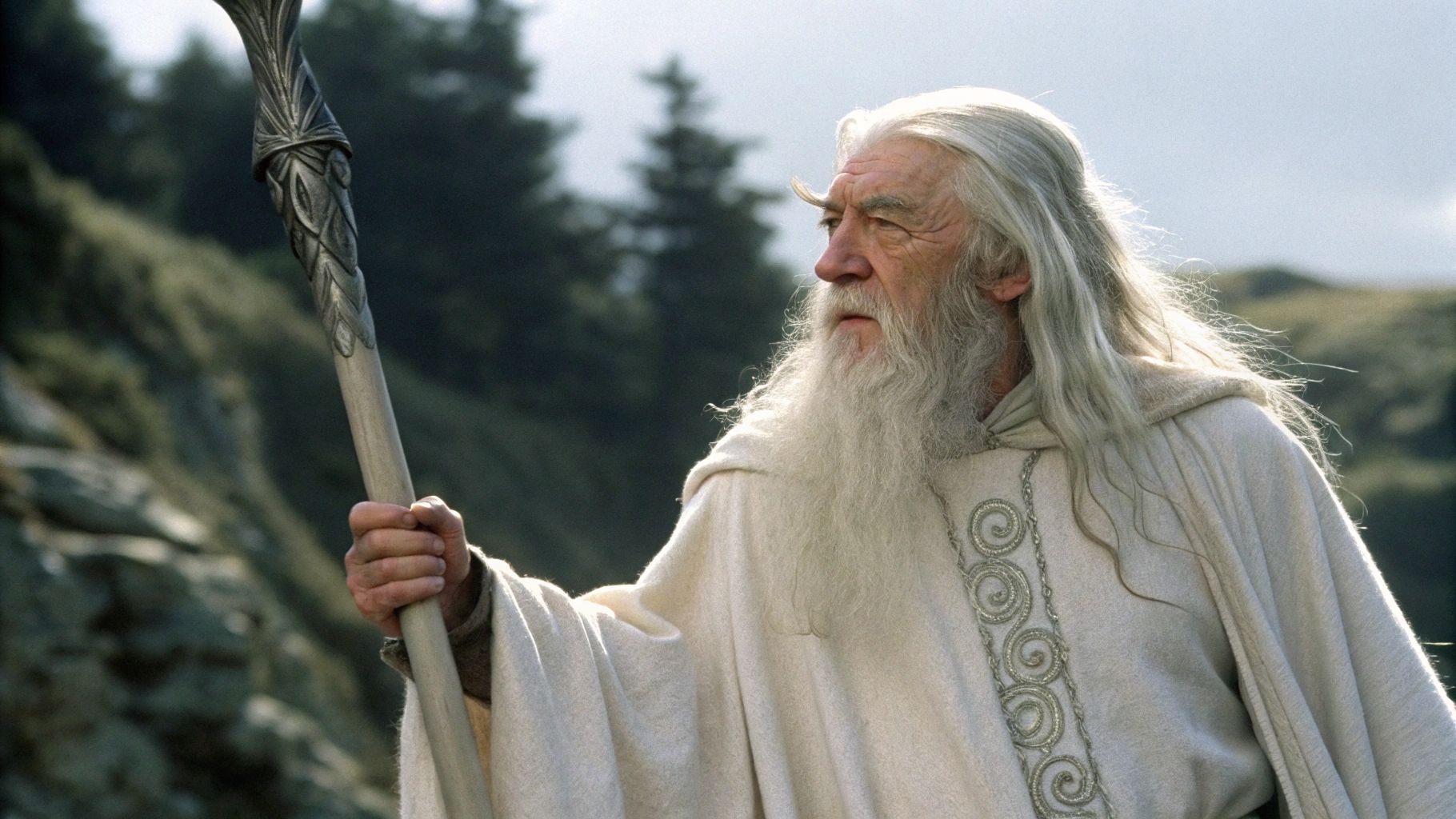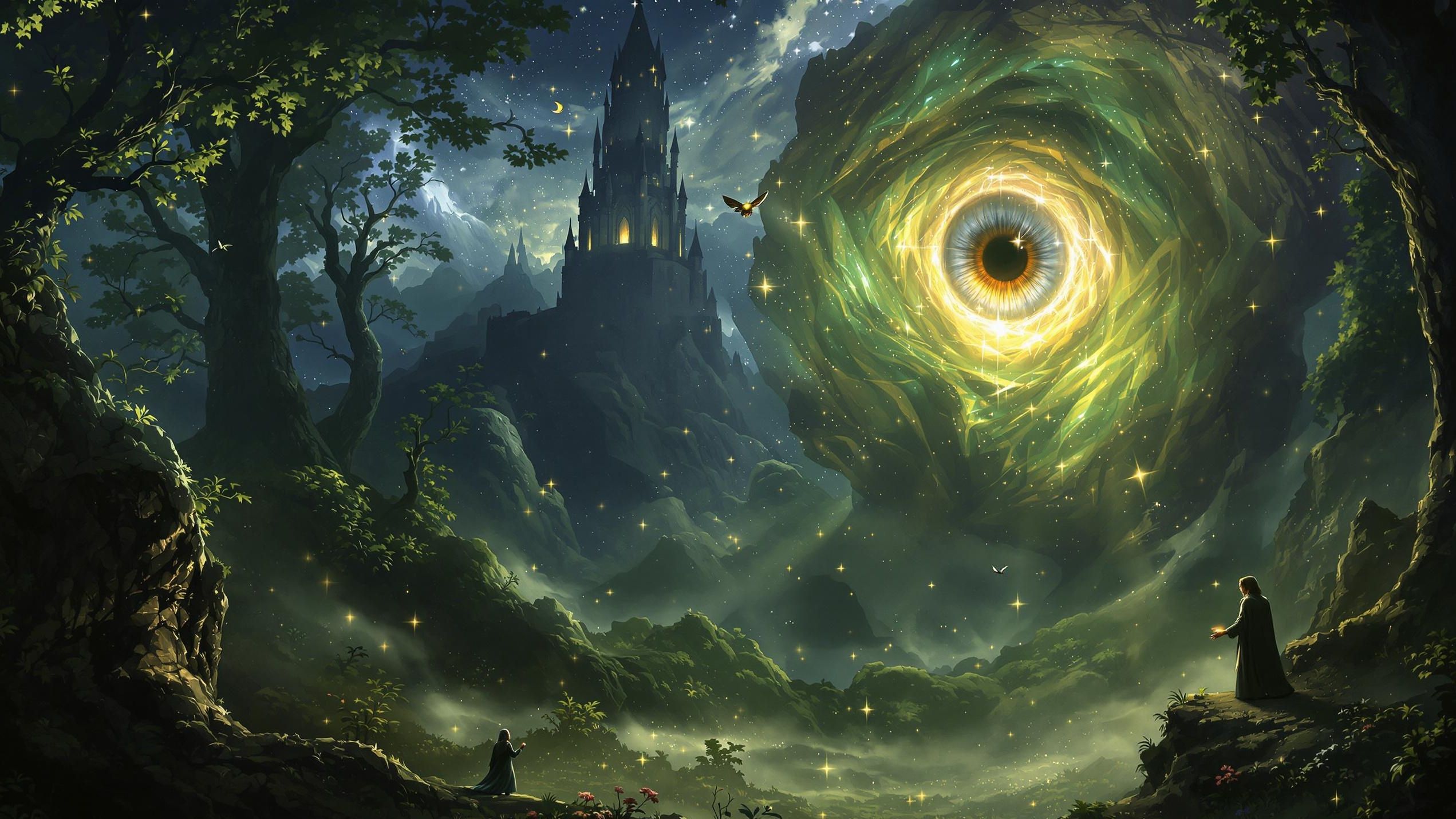Gandalf wasn’t your average spellcaster. He wasn’t flashy like a firework show (except when he wanted to be), and he didn’t carry himself like a god among mortals—even though he absolutely could. As a Maia spirit sent by the Valar, Gandalf walked Middle earth in humble form, guiding, inspiring, and occasionally blasting evil into oblivion when necessary. He was wisdom cloaked in wanderer’s robes, power wielded with restraint, and perhaps the only being who could make both Hobbits and kings listen. From subtle acts of brilliance to unforgettable displays of raw power, these ten moments prove beyond doubt that Gandalf was the ultimate wizard in all of Middle earth.
#10: Outsmarting the Trolls in The Hobbit
In one of Gandalf’s earliest and most clever displays of wizardry, he rescues Bilbo and the Dwarves from three hungry trolls not with spells or lightning, but with sharp wit. While the trolls bicker over how to cook their prey, Gandalf hides in the shadows and mimics their voices, stirring up arguments until dawn arrives and the sunlight turns them all to stone. What makes this moment shine is that Gandalf doesn’t rely on overwhelming magical force—he uses subtlety, timing, and cunning. This scene reveals the essence of his wisdom: he always chooses the least destructive, most effective method. Gandalf knows that sometimes the best magic isn’t found in a staff’s blast but in a perfectly timed word. The petrified trolls later become a bit of Middle-earth scenery (and a funny Easter egg in The Fellowship of the Ring), but it all started with one wizard’s brilliant improvisation.
#9: Investigating the Necromancer in Dol Guldur
Long before Sauron openly returned to power, Gandalf was already on his trail. In The Hobbit films and Tolkien’s writings, he ventures alone into Dol Guldur—the dark fortress of Mirkwood—where he suspects a dark force is rising. What he finds is terrifying: the Necromancer, a shadowy form of Sauron himself, has begun to reawaken. Most would flee such a place or send an army. Gandalf, true to form, walks straight into the heart of darkness armed with his courage, his staff, and his resolve. Though captured and tortured briefly, his resilience forces Sauron to reveal himself prematurely, helping the White Council act before it’s too late. This moment cements Gandalf as not just a protector, but a seeker of truth—one who’s willing to face evil before others even believe it exists. The scene also underscores the burden he carries while others enjoy peace, he walks into shadow to preserve it.
#8: Escaping Orthanc and Defying Saruman
When Gandalf confronts Saruman in Isengard and discovers his betrayal, he doesn’t bow or yield—even when his fellow wizard turns violent. Trapped atop the tower of Orthanc, Gandalf seems finished. But then he does what only Gandalf can: he turns captivity into an opportunity. With the help of Gwaihir the Windlord, an eagle he once aided, Gandalf escapes in dramatic style, soaring away from the clutches of corruption. This moment shows several core traits: his deep connections to the natural world, his foresight in forging friendships that matter, and his refusal to break under pressure. It’s a subtle but powerful display of his status as a being beyond mortal bounds. While Saruman delves into machinery and control, Gandalf remains attuned to harmony and freedom—making him a wizard not of domination, but of balance and courage.
#7: Driving Off the Nazgûl at Weathertop
Few things in Middle earth are more terrifying than the Nazgûl, the Ringwraiths who serve Sauron. When they begin hunting Frodo, it’s Gandalf who first confronts them at Weathertop. Though the scene isn’t detailed in Tolkien’s core text, it’s referenced that Gandalf holds them off for an entire night, blazing the hilltop with fire to keep them at bay. The implication? A one-man stand against nine ancient wraiths using nothing but willpower and elemental magic. This moment highlights Gandalf’s true magical might, which is rarely put on full display. The fire he conjures is not just physical—it’s spiritual, driving back creatures of fear and shadow. When dawn breaks and the Nazgûl flee, it’s not just a victory for Gandalf—it’s a beacon to all that even the darkest evil can be pushed back by a single light. And in Gandalf’s case, that light burns with both fury and purpose.
#6: Breaking the Bridge of Khazad-dûm
Perhaps one of the most iconic moments in fantasy history is Gandalf’s last stand against the Balrog in the mines of Moria. As the Fellowship flees across the narrow bridge, the monstrous fire-demon emerges—and Gandalf, in full command of his power, turns to confront it. He slams his staff, shouts the immortal words “You shall not pass!” and breaks the bridge beneath the Balrog. In that instant, Gandalf isn’t just a guide—he’s a shield between his friends and annihilation. But what elevates this moment beyond mere heroics is his sacrifice. He knows what it will cost and still does it. The fall, the flame, the silence—it’s a haunting image of a wizard laying everything on the line not for glory, but for duty. This battle shows Gandalf’s full might, but also his greatest strength: selflessness.
#5: Battling the Balrog as Gandalf the Grey
After his dramatic fall from the Bridge of Khazad-dûm, Gandalf doesn’t die immediately. Instead, he and the Balrog plunge into the deep abyss, locked in an epic battle that rages for days. They fall through shadow and fire, from the deepest dungeons to the peak of Zirakzigil. There, Gandalf finally defeats the ancient demon—but at a great personal cost. He dies, not in vain, but victorious, having protected the Fellowship and vanquished one of Morgoth’s deadliest creations. This battle is unlike any other. It’s not just physical; it’s a spiritual clash between light and shadow, old and older. Gandalf doesn’t survive through brute force, but through resilience, determination, and divine purpose. This moment reveals the deeper truth of Gandalf’s nature: he is not merely a wise man, but a divine emissary, a Maia sent by the Valar to safeguard Middle earth. His willingness to fight in the shadows where no one could see, for a cause greater than himself, confirms that he’s not only a warrior but a guardian. This is the defining point where Gandalf ceases to be “just” the Grey Pilgrim and begins his transformation into something far greater.
#4: Returning as Gandalf the White
When Gandalf returns to Middle earth, resurrected and radiant, it is a moment of awe. No longer the Grey wanderer, he emerges as Gandalf the White—stronger, clearer in purpose, and ready to challenge even the mightiest of foes. His first act as the White Wizard? Breaking Saruman’s power over King Théoden. He enters the halls of Rohan cloaked in light, revealing his identity only after confronting Saruman’s manipulative influence through Gríma Wormtongue. With commanding presence and celestial authority, he heals Théoden’s spirit, essentially exorcising Saruman’s poison. It’s a stunning act of spiritual and mental magic, achieved not through spells, but through sheer power of will and divine authority. This rebirth isn’t just a power-up; it’s a promotion. He now holds Saruman’s place as head of the Istari and wields the authority to rally kingdoms. His humility remains, but his mission has intensified. This transformation is the final seal that Gandalf is not just a wizard—he’s a force of destiny, a living answer to the growing darkness.
#3: Rallying the Riders of Rohan at Helm’s Deep
As darkness falls over Helm’s Deep and all hope seems lost, it’s Gandalf who arrives at dawn with salvation in hand. Before the battle, he had ridden off alone, promising to return—but not even Aragorn knew what he was planning. True to his word, Gandalf appears at first light on the ridgeline, leading Éomer and a fresh battalion of Riders. He charges into the fray, a blaze of white light, scattering Uruk-hai and turning the tide of war. It’s a cinematic moment, yes, but also a masterstroke of strategy. Gandalf didn’t just win a battle—he orchestrated a rescue that saved Rohan from extinction. His understanding of timing, terrain, and morale is unmatched. In this moment, he is not simply a wizard; he is a general, a strategist, and a symbol of hope. His power is as much psychological as magical. When the light of his staff breaks through the darkness, it becomes clear: Gandalf doesn’t just fight evil—he inspires others to rise against it.
#2: Breaking Saruman’s Staff
After the victory at Helm’s Deep, the attention turns to Isengard, where Saruman has barricaded himself in Orthanc. The White Council debates what to do with him, but it’s Gandalf who takes control. With calm authority, he confronts Saruman from the base of the tower. Saruman attempts to manipulate, charm, and threaten him—but Gandalf is unmoved. Then, with a simple command, Gandalf shatters Saruman’s staff and strips him of his rank. No battle, no chaos—just undeniable authority. This moment is one of pure power, and it’s not flashy—it’s judgment. Gandalf doesn’t gloat or seek vengeance. He simply does what must be done. Saruman, once the most powerful of the Istari, is reduced to a shadow by Gandalf’s will. This act of removing corruption and asserting rightful leadership cements Gandalf as the ultimate wizard—not because he seizes power, but because he bears it with justice and humility. He understands that power must serve good, and he doesn’t hesitate to wield it when the time comes.
#1: Standing Against the Dark Lord’s Army at the Gates of Mordor
In the final stand before the Black Gate, Gandalf leads the combined forces of Men—knowing full well they are outnumbered and may not survive. But it’s all part of the plan. This final confrontation is not about victory on the battlefield; it’s a distraction, a last hope to buy Frodo time. Gandalf knows this and still stands at the front, fearless. When the gate opens and the Mouth of Sauron emerges with lies and intimidation, it’s Gandalf who steps forward and rejects despair. And when Sauron’s entire army pours out, Gandalf doesn’t falter—he holds his ground. His leadership in this moment is beyond strategic—it’s spiritual. He carries the weight of every life behind him and channels that into unwavering courage. As a commander, a guardian, and a beacon, Gandalf shines brightest here—not because of what he casts or conjures, but because he gives everyone hope. That’s what sets him apart. He’s not just Middle-earth’s greatest wizard because of his power—but because he chooses to use that power for others, every single time.
Gandalf’s legacy is more than spells and staves—it’s wisdom, sacrifice, and the ability to inspire others to greatness. Whether he was lighting up the dark at Weathertop, battling ancient demons, or guiding kings and Hobbits alike, Gandalf consistently chose the path of courage and compassion. His magic was never about domination—it was about balance, purpose, and hope. As both Gandalf the Grey and Gandalf the White, he shaped the fate of Middle earth not through sheer might, but through the strength of character. He didn’t just cast spells—he changed lives. That’s why, in a world full of wizards, there is only one who truly stands above them all. Gandalf is, and always will be, the ultimate wizard.




